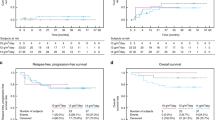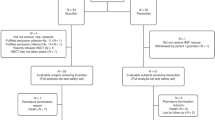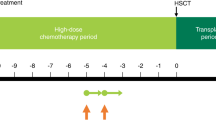Abstract
Major dose-limiting factors of high-dose thiotepa (TEPA) and melphalan are life-threatening mucositis and neurotoxicity. To administer a maximum dose of these drugs safely and to obtain a maximum anti-cancer effect, a double-conditioning regimen with a single grafting, two cycles of administration of a combination of TEPA (300–600 mg/m2) plus melphalan (70–150 mg/m2) with a 1-week interval was attempted in 20 patients with pediatric advanced or chemotherapy-resistant solid tumors (seven rhabdomyosarcoma, four hepatoblastoma, three neuroblastoma and four other malignancy). Combinations of TEPA plus melphalan/busulfan (Bu) (8–10 mg/kg) and TEPA plus Bu were given to four and two patients with brain tumors, respectively. In an additional two patients, three cycles of drug administration were performed. According to the results of the dose-escalating study, the maximum tolerable doses of TEPA and melphalan for children aged 2 years old or older were 1000 mg/m2 and 280 mg/m2, respectively. Mucositis was dose-limiting. Renal toxicity was also dose-limiting in young children (<2 years old). there were two treatment-related deaths (7%) (fungal pneumonia and renal tubular acidosis). among 13 patients who received high-dose chemotherapy during cr, 10 are alive with no evidence of disease (15–59 months, median: 35 months) and in 13 evaluable patients without cr, six are alive without regrowth of the disease (14–59 months, median: 39 months). thus, these novel conditioning regimens allowed us to increase the dose intensity to nearly the maximum for each drug and seemed to reduce adverse effects compared to previously reported regimens with these drugs. with regard to the effect on outcome, the results of this study seem to be encouraging, but a further study on a larger number of patients is required.
This is a preview of subscription content, access via your institution
Access options
Subscribe to this journal
Receive 12 print issues and online access
$259.00 per year
only $21.58 per issue
Buy this article
- Purchase on Springer Link
- Instant access to full article PDF
Prices may be subject to local taxes which are calculated during checkout
Similar content being viewed by others
Author information
Authors and Affiliations
Rights and permissions
About this article
Cite this article
Hara, J., Osugi, Y., Ohta, H. et al. Double-conditioning regimens consisting of thiotepa, melphalan and busulfan with stem cell rescue for the treatment of pediatric solid tumors. Bone Marrow Transplant 22, 7–12 (1998). https://doi.org/10.1038/sj.bmt.1701283
Received:
Accepted:
Published:
Issue Date:
DOI: https://doi.org/10.1038/sj.bmt.1701283
Keywords
This article is cited by
-
High-dose thiotepa, in conjunction with melphalan, followed by autologous hematopoietic stem cell transplantation in patients with pediatric solid tumors, including brain tumors
Bone Marrow Transplantation (2023)
-
Peripheral blood progenitor cell collection in pediatric patients optimized by high pre-apheresis count of circulating CD34+ cells and high blood flow
Bone Marrow Transplantation (2019)
-
Pharmacokinetics of thiotepa in high-dose regimens for autologous hematopoietic stem cell transplant in Japanese patients with pediatric tumors or adult lymphoma
Cancer Chemotherapy and Pharmacology (2019)
-
High-dose thiotepa-related neurotoxicity and the role of tramadol in children
BMC Cancer (2018)
-
Is there a role for high dose chemotherapy and blood stem cell rescue in childhood hepatoblastoma presenting with lung metastases? A case report and literature review
Italian Journal of Pediatrics (2013)



